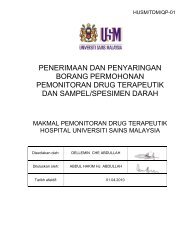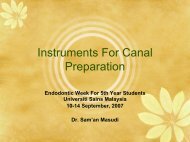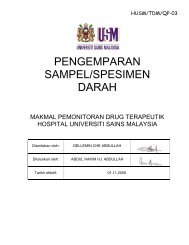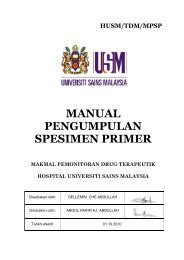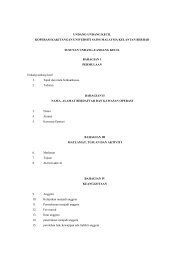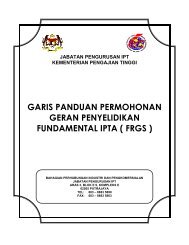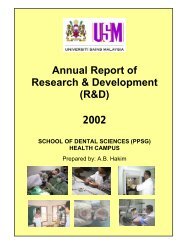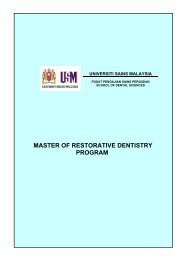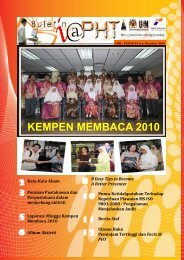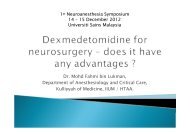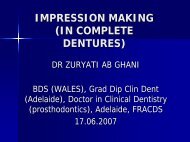Vol 11-R2- Eyelid
Vol 11-R2- Eyelid
Vol 11-R2- Eyelid
Create successful ePaper yourself
Turn your PDF publications into a flip-book with our unique Google optimized e-Paper software.
SRPS • <strong>Vol</strong>ume <strong>11</strong> • Issue <strong>R2</strong> • 2010<br />
the total eyelid width and is restricted to patients<br />
with sufficiently lax lower eyelid skin. The authors<br />
argued that it might be a one-stage alternative<br />
to the modified Hughes flap. Defect sizes in the<br />
study ranged from 5 to 10 mm vertically and from<br />
10 to 22 mm horizontally. The orbicularis muscle<br />
adjacent to the defect was mobilized, incised<br />
vertically, and advanced. The inner surface was<br />
covered with a free tarsoconjunctival graft, and the<br />
outer surface was covered with a free skin graft.<br />
The grafts were obtained from the ipsilateral or<br />
contralateral upper lid. After 5 days of patching,<br />
adequate vascularization and viability of the grafts<br />
were noted in <strong>11</strong> of 13 patients, whereas partial<br />
necrosis of the skin graft was noted in two. The<br />
partial necrosis healed spontaneously, but marked<br />
lower eyelid retraction developed in one of the<br />
two patients. Follow-up examinations 1 year after<br />
surgery revealed marked lower lid retraction (>2<br />
mm) in only one patient; six patients had mild<br />
lower lid retraction of ≤2 mm. Two patients<br />
experienced ectropion and lower eyelid sagging<br />
resulting from excessive horizontal eyelid laxity. The<br />
conditions were successfully treated with additional<br />
block excision. One patient experienced adhesions<br />
between the upper and lower lid in the lateral<br />
canthus. After division of the adhesions, the results<br />
were good. The authors warned against using this<br />
technique for patients with impaired vascularity<br />
(e.g., patients who have undergone radiation<br />
treatment, smokers, diabetics, and patients with<br />
other vasculopathies). The authors have not applied<br />
this technique for reconstruction of vertical defects<br />
>10 mm because they suspect that could lead to a<br />
high rate of postoperative lid retraction because of<br />
vertical tension on the orbicularis muscle flap.<br />
In the event of unilateral total loss of full<br />
thickness of the upper and lower eyelids with<br />
the globe remaining, preservation of vision and<br />
adequate corneal protection are the primary goals;<br />
secondarily, the eyelids need to be sufficiently<br />
mobile to open and clear the visual axis. deSousa et<br />
al. 133 described six cases. The cause of tissue loss was<br />
traumatic avulsion in one case and tumor excision<br />
in five. In addition to loss of both upper and lower<br />
32<br />
eyelids, the medial and lateral canthal tendons and<br />
canaliculi were lost. In the trauma case, primary<br />
repair was achieved by using the avulsed tissues.<br />
After tumor excision, a single anterior lamellar flap<br />
was used with planned division postoperatively in<br />
one case; the remaining four cases had separately<br />
reconstructed upper and lower eyelids. In one case,<br />
the posterior lamella was recreated by using a free<br />
tarsal graft from the contralateral upper eyelid for<br />
the upper eyelid and a hard palate graft for the<br />
lower eyelid. Bipedicled flaps of the remaining<br />
preseptal and orbital orbicularis were formed in<br />
the upper and lower eyelids to cover the posterior<br />
lamellar composite grafts. A single large free skin<br />
graft from the supraclavicular fossa was placed over<br />
the eyelids, and a central fenestration was created<br />
to form the new palpebral aperture. The remaining<br />
sub-brow defect was repaired by using a laterally<br />
based forehead flap. In another case, a large nasal<br />
septal chondromucosal graft was harvested and<br />
divided to reconstruct separate upper and lower<br />
eyelid posterior lamellae. A single midline forehead<br />
flap was used for the anterior lamella. Flap division<br />
was performed at 6 weeks, with restoration of a<br />
small palpebral aperture. In one other case, the<br />
authors created an islanded, pedicled suprabrow<br />
forehead flap based on the anterofrontal superficial<br />
temporal artery branch for the anterior lamella<br />
of the upper eyelid. The flap was elevated on its<br />
vascular pedicle and tunneled under the remaining<br />
lateral canthal skin. A free tarsal graft was used<br />
for the posterior lamella of the upper eyelid. A<br />
midline pericranial flap was raised and tunneled<br />
under the glabellar skin to form the lower eyelid<br />
posterior lamella and to provide a blood supply<br />
for an overlying free supraclavicular skin graft. The<br />
reconstructed upper and lower eyelids were secured<br />
together, leaving a small central palpebral aperture.<br />
Graft necrosis occurred in three cases. In all cases,<br />
lagophthalmos was present and the reconstructed<br />
eyelids were stiff and immobile. Ptosis and lower<br />
eyelid retraction occurred in half the cases, and<br />
ectropion resulted in two cases. Useful vision was<br />
retained in all cases.



